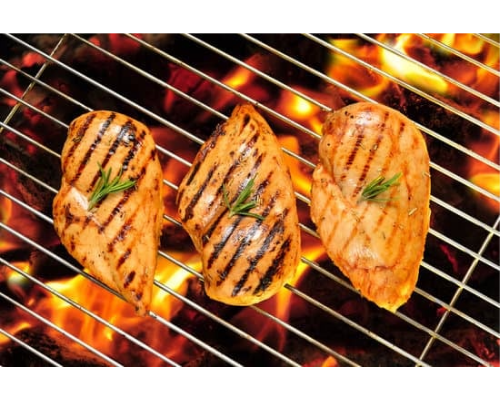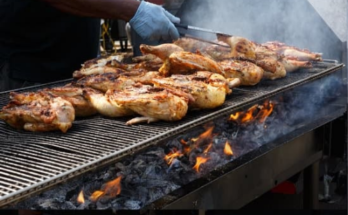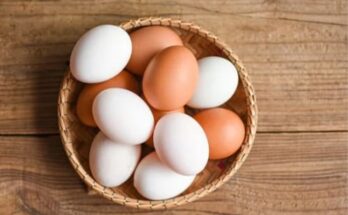Cooking of meat:
Cooking can make meat more tender or less tender than the original raw cut. When meat is cooked, three types of changes contribute to increased tenderness. They are the melting of fat, dissolution of collagen in hot liquids to become soft gelatin, and tissue softening and muscle fibre separation. There are also toughening influences of heating. Overheating can cause muscle fibres to contract and meat to shrink and become tougher; evaporation of moisture occurs and dried out tissues become tougher.
There are two methods of cooking meat: the dry heat and moist heat methods. Selection of the method to use for a meat cut depends upon whether it is a tender or less tender cut. Less tender cuts become more tender when prepared by moist heat methods since this provides a means for the conversion of collagen to gelatin. Moist heat methods of cooking include braising, stewing (cooking in simmering water) and pressure cooking. Ten- der cuts do not require the conversion of connective tissue. Then, they are cooked by dry heat methods, which include roasting, broiling, pan broiling and frying.
For any method of cooking, an appropriate cooking temperature must be chosen. Generally, lower cooking temperature for a longer period of time is better than a higher temperature for short periods of time for any degree of doneness. This results in decreased drip loss, less shrinkage, increased juici- ness and more uniform colour throughout the cut.
Testing for doneness is an important aspect in meat cookery. This is tested by the use of a meat thermometer. The recommended temperature in the centre of cut for rare, medium and well done stages is 77°C to 82°C
Changes during Meat Cooking:
A number of changes take place during the cooking of meat. Heat destroys the microorganisms that may have contaminated meat. It also brings about changes in colour, flavour and tenderness owing to changes taking place in meat fibre and connective tissue. At high temperatures, there is a conside- rable shrinkage of meat, toughening of protein and loss of juiciness.
Cooking brings about changes in the colour of the meat. When fresh meat is cooked, its protein pigments are denatured. Denaturation of the proteins causes rapid release of the haem pigments from the globin part of the molecule, and the free haem is very sensitive to oxidation. On heating, therefore, red meat generally turns brown due to the oxidized pigments. However, the extent of denaturation depends upon the temperature to which meat has been cooked. The changes in the colour of pigment in meat, when heated, are used as an index of doneness. Meat cooked to rare condition has less of oxymyoglobin denatured and is more red. Well done meat is more denatured and more brown. However, meats cured with nitrite re- main red throughout cooking.
Heat treatment brings about the denaturation of most other proteins. Thus, the enzymes present in meat are inactivated. Myosin and actin are also enzymes and their inactivation brings about textural changes since the contractile proteins become tougher. However, very often this is counter- acted by the concomitant conversion of the collagen of the connective tis- sues to gelatin. This is the reason why tough cuts of meat are cooked for a long time in the presence of water.
Ideal cooking methods for meat should minimize the hardening of contractile proteins and maximize the softening of the connective tissues. Cooking temperature and time should be adjusted so that the tenderizing effect due to the conversion of collagen to gelatin is not offset by the increasing toughness owing to an excessive coagulation of contractile proteins.
Many components of meats are responsible for its flavour. With heating, several of the components undergo changes. Proteins and free amino acids of meat, on heating, produce some volatile breakdown products. These include sulphur-containing compounds, aldehydes, ketones, alcohols, amines and others. Lipid components also break down into various volatile compounds. These volatile compounds in both the fat and lean portions of the meat, contribute to the flavour and odour of cooked meats.
During heating, meat fat melts, adipose tissue cells are ruptured, and there is a redistribution of fat. Some fat is dispersed finely in locations where collagen has been hydrolyzed. When meat is eaten warm, the melted fat serves to increase the palatability of the product by giving a desirable mouthfeel.
Meat contains a high percentage of water. Only a small percentage of this water is bound very closely to the protein of muscle tissue and the rest exists as free molecules within the muscle fibres and connective tissues. Heating reduces the water holding power of meat. The water holding capacity of meat, among other things, is related to its juiciness. The loss of water on cooking does not bring about changes in the nutritive value of proteins, and done stages are more juicy than well done meats.
The nutritional value of cooked meat generally remains high. Normal cooking does not bring about changes in the nutritive value of proteins, and minerals are not lost by heat. Some minerals may be lost in meat drippings but, on the other hand, cooking dissolves some calcium from bone and so enriches the meat in this mineral. There is loss of some B vitamins during cooking. But most of the cooked meat retains more than 50 % of the B vitamins present in the uncooked meats.





I have recently started a web site, the info you offer on this website has helped me tremendously. Thanks for all of your time & work.
I’ve been exploring for a little bit for any high quality articles or blog posts in this sort of space . Exploring in Yahoo I at last stumbled upon this site. Reading this information So i am satisfied to convey that I’ve an incredibly excellent uncanny feeling I discovered exactly what I needed. I most unquestionably will make certain to don’t fail to remember this site and give it a glance regularly.
Hey! I know this is kinda off topic however I’d figured I’d ask. Would you be interested in trading links or maybe guest authoring a blog article or vice-versa? My blog covers a lot of the same topics as yours and I feel we could greatly benefit from each other. If you might be interested feel free to shoot me an e-mail. I look forward to hearing from you! Awesome blog by the way!
I’ve been exploring for a bit for any high-quality articles or blog posts on this kind of area . Exploring in Yahoo I at last stumbled upon this site. Reading this information So i’m happy to convey that I have a very good uncanny feeling I discovered just what I needed. I most certainly will make sure to don’t forget this web site and give it a look regularly.
Its such as you read my thoughts! You appear to know so much approximately this, such as you wrote the e-book in it or something. I believe that you simply could do with some percent to drive the message house a bit, but other than that, this is wonderful blog. A great read. I will certainly be back.
You can definitely see your skills in the paintings you write. The world hopes for even more passionate writers such as you who are not afraid to mention how they believe. Always go after your heart. “If you feel yourself falling, let go and glide.” by Steffen Francisco.